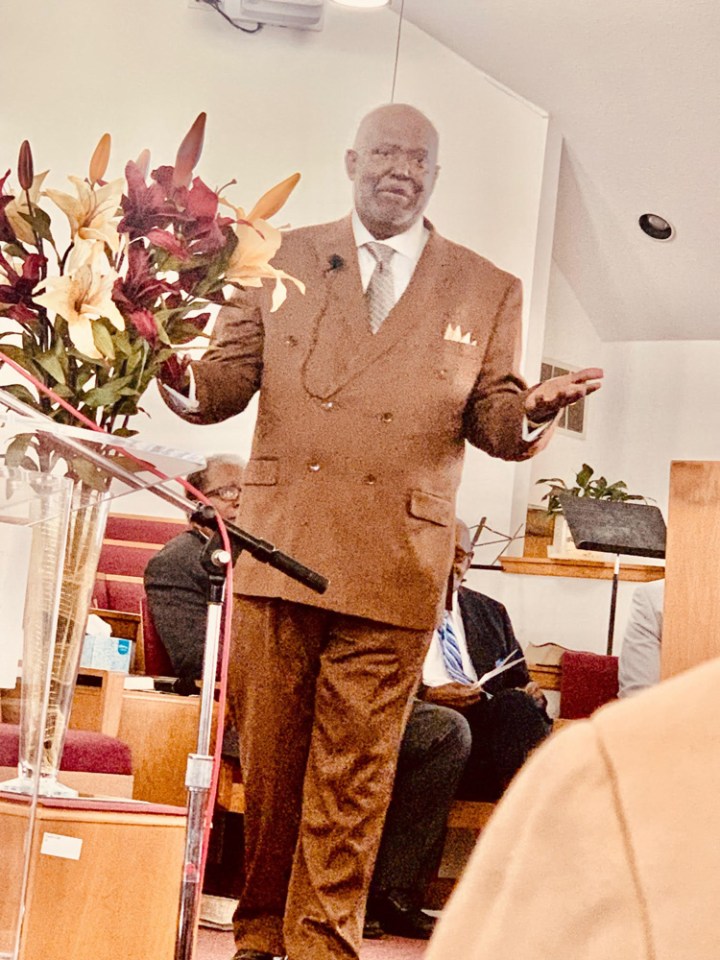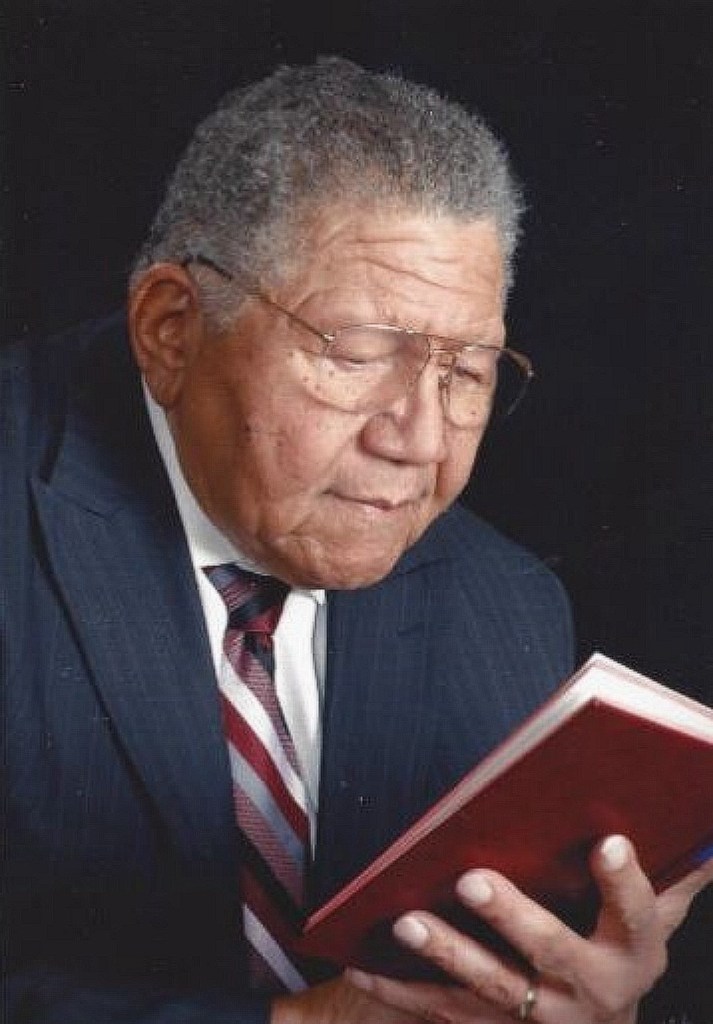C.B. Bailey (March 29, 1923-Sept. 5, 2009), longtime Pastor of Salem Baptist Church in Kansas City, Kansas (photograph courtesy of Bailey Christian Education Fund cbbailey.com)
With roots in Africa, all variants include a call to social justice, leaving congregants exhilarated, enthused and equipped to take on the challenges of the next week
This article is the third in a series titled “The Art of Blackness.” Says author Harold Smith, “Like assemblage created from found objects, many iconic cultural elements in the Black experience — notably in areas of music, food, hair, clothing — lie at the intersection of both African and American cultures. Like the ‘Big Bang,’ this collision of African creativity and American captivity resulted in an explosion of new ways of personal expression that still reverberates in Black American life.
“As a result, simply experiencing life as a Black American is an artistic endeavor.”
As a child in the 1960s and ’70s, I was raised as a Roman Catholic. We attended Blessed Sacrament Catholic School and Church in Kansas City, Kansas. The school was orderly and disciplined. The masses were short, formal and routine. The service was so quiet that, as old Black folk would say, “You could hear a mouse piss on cotton.” (However, I do recall in the early ’70s when a tall, skinny, long-haired young white man stood up and said “Amen” during the homily. Folks talked about it for weeks.)
We lived down the street from 13th and Quindaro. So, most of my friends were Baptist, Methodist, Pentecostal and other Protestant denominations. There was a small Baptist church on Valley Street, literally a block behind our house. Unlike the short and reserved Catholic masses, their energetic services stretched into the early afternoons. In the hot summer, when their windows were wide open, I could sit in the backyard and hear the fervent exhortations of the speaker of the day. Pounding the pulpit, he would “preach the saints into the heights of heaven and the sinners into the depths of hell.” With each phrase, a hearty chorus of “Amens” would follow. Accompanied by dramatic chord progressions from the organ, the sermon would reach a crescendo that, like the avant-garde jazz of John Coltrane, would border on the precipice of chaos but eventually subside and leave listeners exhilarated, enthused and equipped to take on the challenges of the next week.
Black preaching is an art form. It comforts the afflicted and afflicts the comfortable.
Theo Davis, a Black digital pastor and artist, says, “Preaching is absolutely an art form. To draw out insights and inspire people to life change requires a mastery understanding of how to bridge cultures thousands of years apart into language that impacts us today.
“For me, preaching is like painting a picture live for the audience. Each Sunday you have access to every color of paint, but you choose to focus on just two colors — a limited palette. And you reveal something you didn’t even think was possible with just two colors,” he added.
The same way that Black painters have often stood out for using vibrant colors and imagery to bring attention to social issues and underrepresentation, Black preachers stand out for their use of volume, enunciation and rhythm to connect with their audiences on an emotional level.

Melvin Lamont Brown, a parent-school liaison for Kansas City Public Schools, states, “My mother, both grandmothers, and grandfathers were all preachers, and I was raised and reared in the Missionary Baptist Church. There was always something spectacular about how the pastor would start off teaching and expounding and the way he would use his voice and then when he got to second and third gear he’s raring up and tuning up and hooping.
I done seen women’s wigs fall off and people fall out in between the pews. I wouldn’t have traded my upbringing for nothing. I loved and still love all of it.”
As in the art of soul food and the art of Black gospel music, the iconic elements that make Black preaching unique can be traced back to Africa. One of these elements is called “whooping.” Also called, “hooping,” it is a style of Black preaching that many Black preachers typically use to close a sermon. It is celebratory and rhythmic and usually morphs into outright singing. It is taught in some Black theological seminaries. Legendary Black preacher Jasper Williams even offers a course in “Hoopology.” (https://youtu.be/wkMJE4KqcgE)

According to Minister Norm Woodley of Cleveland Avenue Baptist Church, “The art of Black preaching was conceived out of necessity for survival. Our people were enslaved in oppression and inhuman treatment on slave plantations. In order to elicit hope and encouragement, Black preaching had to have powerful messages of hope. To do so voice inflection or whooping was used to speak to the deep emotions of enslaved Black folk. In an often music-backed word/singing, Black preaching continues today to stir the souls of God’s people who are still challenged with persecution. Selah.”
Glenn North, poet and director of education at the Kansas City Museum, says, “The spirited, musical, homiletic of Black preaching came out of the African tradition. When one observes how Africans express their spirituality, we see it is highly animated and spirited. Whooping, hollering, running, and even the dancing in today’s Black church is an extension of that.
“In the early Black church, the pastor was often the only person who could read. So, he had to present the information in a way that was unforgettable to the congregation. As a result, the sermons were often highly descriptive, detailed, and laced with adjectives designed to burn the message into the mind of the listener.”
African roots have resulted in creative DNA shared between Black preaching, soul music, soul food, jazz and blues music, Black fashion, hip hop and Black visual art, among others. Whether it’s Aretha Franklin’s “Respect,” James Brown’s “It’s a Man’s World,” Muddy Waters’ “Hoochie Coochie Man” or Queen Latifah’s “U.NI.T.Y.,” one can hear the influence of the Black church, a resourcefulness of sound and word that speaks to creating something rich from that which is often deemed as lacking aesthetic value.
The call and response nature of Black preaching can also be found in Black visual art and fashion. Comparing Bob Thompson’s 1964 vibrant rendition of “Triumph of Bacchus” in the collection of the Whitney Museum of American Art to Diego Velázquez’s 1628/1629 version of the theme elicits similar parallels to comparing Black preaching to white preaching. In the commentary on Thompson’s work, the Whitney website states, “The flattened forms and silhouettes evoke the undulating rhythms and syncopated movement found in jazz music, which Thompson deeply admired, and create an abstracted, dreamlike atmosphere that renders place and time indistinct.” The spirited and musical homiletic of which Glenn North spoke is present here.

Black preaching, as an art form, may share the same DNA, but it is not monolithic. Not all yell or whoop, but all variants include a call to social justice in their content. As Odell Talley, a gospel keyboardist who has played on both sides of the river for 30 years, reminisced, “Back in the day, there was a variety of styles to choose from on any given Sunday. Dr. Freeman at First Baptist basically lectured and used a lot of parables and simple illustrations. Rev. Henderson, and later Rev. Preston, at Eighth Street Baptist included quotes by theologians and even authors in their preaching. Dr. Mac Charles Jones at St. Stephens quoted Langston Hughes and other Black writers. Rev. C.B. Bailey at Salem Baptist was high energy from start to finish. Rev. David Gray at Pleasant Green brought a fiery intensity every week. Dr. Charles Briscoe at Paseo Baptist was very earnest in his appeals to human decency. Elder James White at Bethel Seventh Day Adventist made you want to run to the pool and get baptized.
“They were all different, but they all made you see your Blackness as a blessing and not a curse.”
When one considers that most Black artists were raised in the Black church, a listen to Black preaching can help one gain a greater appreciation for other Black artistic expressions. In the affirming work of Faith Ringgold, one can also hear the comforting words of Dr. Martin Luther King, the impassioned singing of Mahalia Jackson, the musical fist of Public Enemy, and feel the graceful elegance of Misty Copeland. In the vibrant and celebratory quilts of Bisa Butler, one can also hear the compassionate and empowering words of Rev. Dr. William J. Barber II, the tender singing of Billie Holiday, the cool jazz of Miles Davis, the exuberance of the Sugarhill Gang, and feel the movements of Alvin Ailey’s Revelations.
As expected, Black preaching styles have been appropriated by white preachers. As reported in a November 1997 article in the Atlanta Journal Constitution, “And now hooping is getting attention from an unexpected source — white pastors. National television networks like Trinity Broadcasting are full of fiery white pastors who are trying to prove that white men can hoop,”
When one considers all the obstacles faced by the Black community, Blackness is an artistic experience in itself. From hairstyles to food to music to fashion and beyond, the struggle of Black survivability and visibility has dictated that Blackness in these areas creates genres and trends that exist outside but also alongside the genres and trends created and controlled by the dominant culture. Instead of constantly fighting the gatekeepers guarding the communities of acceptability, we go into the woods, cut down trees and build our own.
In other words, “We out here being Blacktacular in everything we do.”
And that includes preaching.
This post was originally published on this site be sure to check out more of their content.







